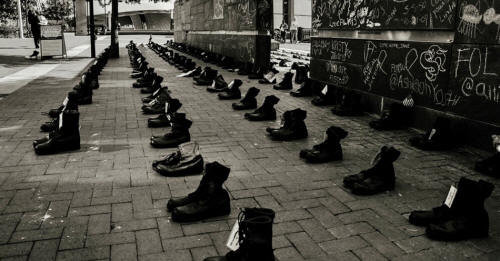The United States has spent
$1.6 trillion on post-9/11 military operations,
including the wars in Iraq and Afghanistan, weapons
procurement and maintenance, and base support, according
to a
report (The
Cost of Iraq, Afghanistan, and Other Global War on
Terror Operations Since 9/11) issued earlier this month by the
Congressional Research Service (CRS).
As some analysts
point out, that's more money than the U.S. spent on
the Korean War, the Vietnam War, and the Persian Gulf
War of 1990-1991 all rolled into one.
According to
International Business Times,
"the $1.6 trillion
estimate, which comes to $14 million per hour since
9/11... is up roughly half a trillion dollars from
its 2010 estimate, which found that the post-9/11
military operations are second only to World War II
in terms of financial cost."
Of the $1.6 trillion total,
CRS specialist Amy Belasco estimates that the funding
breaks down as such:
-
$686 billion (43%)
for Operation Enduring Freedom (Afghanistan)
-
$815 billion (51%)
for Operation Iraqi Freedom/Operation New Dawn
(Iraq)
-
$27 billion (2%) for
Operation Noble Eagle (providing enhanced
security at military bases and
military operations related to homeland
security)
-
$81 billion (5%) for
war-designated funding not considered directly
related to the Afghanistan or Iraq wars
The report, dated December
8, states that about 92 percent of the funds went to the
Department of Defense, with the remainder split between
the State Department, the Department of Veterans
Affairs, and other agencies.
The key factor determining
the cost of war during a given period over the last 13
years has been the number of U.S. troops deployed,
according to the report.
To that end, the document
says that predicting,
"future costs of the new
U.S. role in countering the Islamic State is
difficult because of the nature of the air campaign
and uncertainties about whether the U.S. mission may
expand."
To curtail costs moving
forward, the CRS analysis recommends:
"Congress may wish to
consider ways to restrict war-funding to exclude
activities marginally related to war operations and
support, and to limit the use of ground troops in
Operation Inherent Resolve," referring to the U.S.
military intervention against the Islamic State, or
ISIS.
Writing at the
Federation of American Scientists blog - where the
report was first posted -
Steven Aftergood says:
"Ideally, the record
compiled in the 100-page CRS report would serve as
the basis for a comprehensive assessment of U.S.
military spending since 9/11:
-
To what extent was
the expenditure of $1.6 trillion in this way
justified?
-
How much of it
actually achieved its intended purpose?
-
How much could have
been better spent in other ways?"
Mother Jones
notes that,
"[o]ther reports have
estimated the cost of U.S. wars since 9/11 to be far
higher than $1.6 trillion.
A
report by Neta Crawford, a political science
professor at Boston University, estimated the total
cost of the wars in Iraq and Afghanistan - as well
as post-2001 assistance to Pakistan - to be roughly
$4.4 trillion.
The CRS estimate is
lower because it does not include additional costs
including the lifetime price of health care for
disabled veterans and interest on the national
debt."
Speaking to
The Fiscal Times, American University professor of
international relations and military history Gordon
Adams argues that the costs of war are much higher
than any report could show.
"All of these figures do
not take into account the long-term consequences, in
terms of post-traumatic stress disorder or long-term
veterans' bills," he said.
"The costs go on. Iraq
and Afghanistan will end up being the gift that
keeps on giving because - as we did with Vietnam -
we will be living with the consequences for many,
many years."

